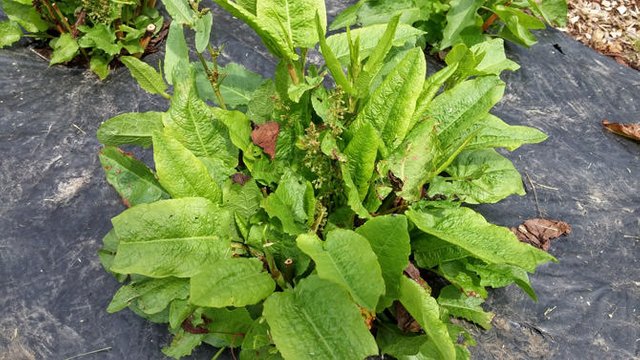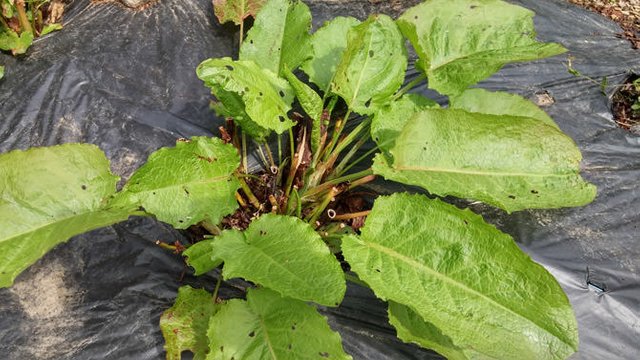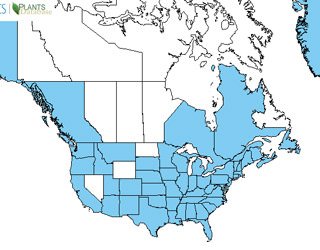Getting to Know Herbs: Bitter Dock
This common dock is a perennial herb sometimes used in salad mixes, vegetable broths or cooked like spinach. Containing oxalic acid, quantities consumed should be limited lest nutritional deficiency or kidney stones develop.

Photo by @krnel
The scientific name is Rumex obtusifolius. Other names include broad-leaved dock, bluntleaf dock, dock leaf, butter dock, common dock, cushy cows, dock plant, kettle dock, lapathum syvestre, paenehua, round leaved dock, smair dock.

Photo by @krnel
Key Points
- used for food or medicine
- contains oxalic acid, a problem if consumed too frequently
- bitter taste limits chance of eating often
- invasive weed
History
There was a saying used when applied as a cure for Nettle stings:
'Nettle in, Dock;
Dock in, Nettle out
Dock rub Nettle out,'
This is the origin of the saying 'In Dock, out Nettle'.
A tea prepared from the roots was once though to cure boils.
A novel set in the 19th century has board dock leaves used to wrap farmhouse butter.
Where is it found?
Bitter dock is native to Europe, from Western Europe, including Britain, from Scandanavia south and east to Spain, Germany and Hungary. It's been introduced to many other areas, like North America, Australia and New Zealand.
It's considered invasive and designated as an "injurious weed" in the UK.
It grows in many places, but prefers shade and moisture. It can be found in woodland area, meadow edges, along creeks, waste grounds, hedgegrows and the margins of fields. It prefers pH balanced soils, but can grow in acidic or alkaline soils as well.
What's it used for?
Young leave are eaten fresh or cooked. They get more bitter as they get older. Cooking reduces the bitterness, as well as changing the water while cooking. Best to collect in early spring. Stems can also be eaten, preferably cooked. The seeds as well, which can be ground into a powder to make gruel or added to cereal flours for bread making.
Leaves have been used in rustic remedies to treat blisters, burns and scalds. The root has tannin which works as an astringent and blood purifier. Teas made from the roots have been used to treat jaundice, whooping cough, boils and bleeding. Infusions made from the roots were used to treat skin eruptions. Other uses include as a contraceptive and to stop menstruation.
Medicinal uses:
Abscess, bleeding, blisters, burns, gum disease, jaundice, leucorrhea, menopause, menstrual disorders, nose vloods, paprkinson's disease, whooping cough, scalds. Astringent, blood purifier, contraceptive, detoxicant, laxative, tonic.
Are there any risks?
The danger is in the calcium oxalates that can bind to calcium (and other nutrients) in the body and lead to deficiency if consumed for a long period of time. They can also lead to the build up of kidney stones if the formation of calcium oxalates is not excreted.
It can also irritate the skin, mouth, tongue, and throat, resulting in throat swelling, breathing difficulties, burning pain, and stomach upset.
Oxalic acid content is reduced when cooked. Those with rheumatism, arthritis, gout, kidney stones or hyperacidity should avoid or be more cautious with use.
References:
Previous posts on Getting to Know Herbs:
Butterfly Weed / Pleurisy Root | Joe-Pye Weed / Gravel Root | Valerian | Malva/Mallow | Boneset | Elecampane | Lungwort | Cramp Bark | Motherwort | Common Plantain | Eleuthero (Siberian ginseng) | Black Cohosh | Common Bearberry | Mahonia Mountain Grape (Oregon Grape) | Blue Cohosh | Goldenseal
Thank you for your time and attention. Peace.
If you appreciate and value the content, please consider: Upvoting, Sharing or Reblogging below.
 me for more content to come!
me for more content to come!
My goal is to share knowledge, truth and moral understanding in order to help change the world for the better. If you appreciate and value what I do, please consider supporting me as a Steem Witness by voting for me at the bottom of the Witness page.


Hah, this one sounds like one to stay away from as far as eating. Picturing the poor souls who first encountered it and tried eating it in large helpings from hunger.
LOL, yes. We learned about the positive and negative from those early "guinea pigs" who tested it out :/
looks familiar, I think I may have had some growing on my lawn, are you cultivating it?
I don't have a lawn :/ I've seen it around though I think at some times in my life...
That saves time mowing.
The history behind these herbs is interesting as you mention with
And so many medical uses for herbs as if it is God's medicine. Thanks @krnel.
Restorative Aspects of Curly Dock Root, Curly Dock root is utilized to tonify the irk bladder and liver. It is a severe tonic, astringent, delicate purgative, and alterative.
On the earth ,some species with particularly high levels of oxalic acid are called sorrels (including sheep's sorrel, Rumex acetosella, common sorrel, Rumex acetosa, and French sorrel, Rumex scutatus), and some of these are grown as leaf vegetables or garden herbs for their acidic taste.
BITTER DOCK
dock leaves are not edible to eat.
There are several sources of food in this family of plants. This article deals predominantly with Rumex crispus; Curly Dock, and R. obtusifolius; Bitter Dock. Not including burdock, which is not in the Rumex family.although sheep sorrel is indeed edible and delicious.but you should be careful selecting these dock
If you would like to support the educational community by delegating to @steemiteducation, please click on any of the following links. This will ensure that more teachers are supported on a daily basis.
100SP 200SP 300SP 400SP 500SP 750SP 1000SP 2000SP 3000SP 4000SP 5000SP 10,000SP 25,000SP